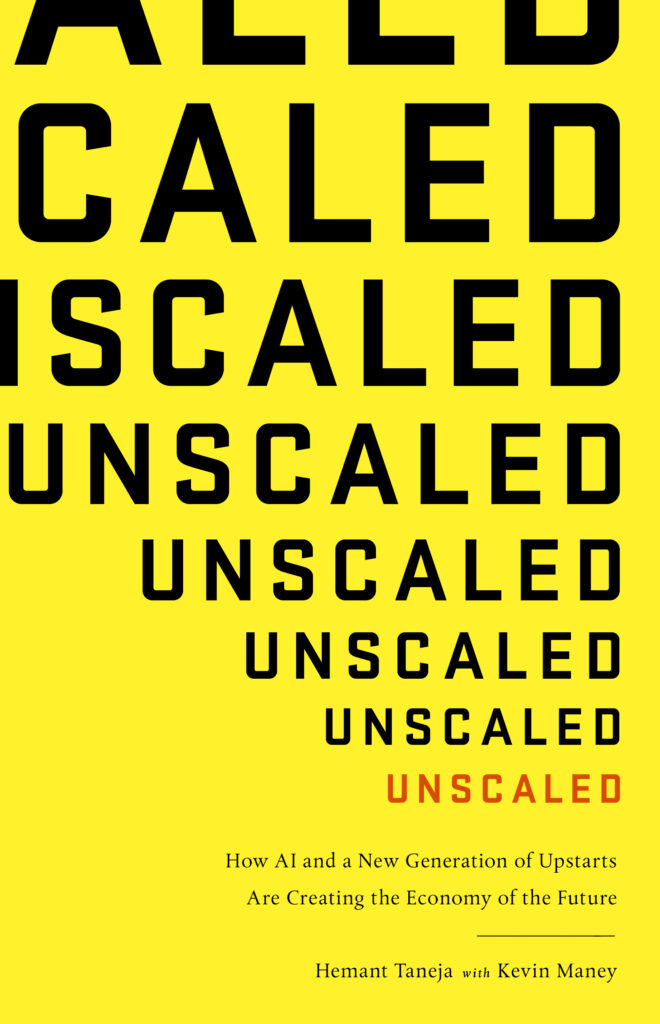In “Unscaled: How AI and a New Generation of Upstarts Are Creating the Economy of the Future” (PublicAffairs), Hemant Taneja with co-author Kevin Maney examines the forces that are turning a long dominant fundamental of business—economies of scale—on its head. They describe how the disruption is playing out in the media and other sectors. Taneja is managing director at General Catalyst, a venture capital firm that has invested in dozens of companies including Bustle and Snap. An excerpt:

Throughout the twentieth century, technology and economics drove a dominant logic: bigger was almost always better. It was smart to scale up—to take advantage of classic economies of scale.
In the twenty-first century, technology and economics are driving the opposite—an unscaling of business and society. This is far more profound than just startups disrupting established firms. The dynamic is in the process of unraveling all the previous century’s scale into hyperfocused markets. Artificial intelligence (AI) and a wave of AI-propelled technologies are allowing innovators to effectively compete against economies of scale with what I call the economies of unscale.
In my work investing in startups as a venture capitalist, unscaling has become my central investment philosophy. I fund or help build companies that can take advantage of AI and other compelling new technologies such as robotics and genomics to peel away business and customers from scaled-up incumbents. By adhering to the philosophy of unscale, our firm has invested early in groundbreaking companies such as Snap, Stripe, Airbnb, Warby Parker, and The Honest Company.
In this century mobile, social, and cloud technologies have done quite a job disaggregating and unbundling media. And yet AI and the economies of unscale have only begun to play out in media. Oddly enough, radio—long one of the less-sexy media sectors—provides a surprising window into how the dynamics of the AI century might further change journalism and entertainment, taking it from mass media to audience-of-one media.The media industry has unscaled more than most—making it an industry that others can learn from. Our unscaled media has brought us many new-era wonders such as Netflix movies on demand and Spotify streaming music. But it has also damaged journalism—an institution critical to the US system—and ushered in media echo chambers that have contributed to divisive politics all over the world. Our current media is an example of what can happen when policymakers fail to think through the implications of unscaling.
In the past the way to make money in radio was to create programming that appealed to a broad audience, get as many listeners as possible, and raise advertising rates. The next-level step was even better: accumulate radio stations, serve standardized music playlists across all of them so fewer personnel would be needed, and centralize ad sales and other business departments. Then, toward the end of the twentieth century, US policy changes helped accelerate scaling in radio. The Telecommunications Act of 1996 ended key rules that prevented any one company from accumulating radio stations and taking undue advantage of economies of scale. Before the 1996 Telecom Act no company could own more than forty radio stations. By the 2010s the biggest radio company, iHeartMedia (formerly Clear Channel), owned more than twelve hundred. The lure of economies of scale set in motion a wave of consolidation as soon as it was allowed, leading to a decline in the diversity of radio programming as companies like iHeartMedia sought to standardize and automate music playlists.
Radio provides a surprising window into how the dynamics of the AI century might further change journalism and entertainment, taking it from mass media to audience-of-one media
But shortly before Congress enacted the 1996 act, radio began experimenting with the internet. In 1994, for the first time, a radio station—WXYC FM in Chapel Hill, North Carolina—fed its broadcast into the internet, allowing anyone anywhere in the world to hear it on a computer. A radio “station'' no longer needed a radio tower to exist, only a URL. Dozens of startups took a shot at internet radio. In 1998 Mark Cuban, now the colorful owner of the Dallas Mavericks NBA team and star of the TV show "Shark Tank," and his lesser-known cofounder Todd Wagner were swept up by the idea that radio broadcasts of college sports could be pumped through the internet and reach fans who might live thousands of miles away. They formed a company, eventually called Broadcast.com, to aggregate internet radio (and later, video, though that didn’t work very well during the dial-up era of the internet). Broadcast.com excited Yahoo so much that it paid $5.7 billion in 1999 to buy it.
Yet under Yahoo Broadcast.com fizzled out and disappeared. Internet radio was having little impact and making no money. In those days of low-fidelity cell phone networks, an internet radio station couldn’t yet reach cars or handheld devices. Advertisers had no idea who was listening. On top of all of internet radio’s challenges, consumers had a hard time finding what they wanted. Internet radio programming was too hard to search.
So the internet created a promise of unscaling, which people like Cuban and Yahoo’s management spotted early, but they couldn't deliver on the profits and business models to make unscaled radio viable. For that, the emerging unscaled radio industry needed a new kind of rentable platform.
This is where an entrepreneur in Texas named Bill Moore came in. He’d gotten an MBA from the University of California, Berkeley, and worked for a half-dozen years at Efficient Networks, a company that sold software to telecommunications firms. Around 2002 he had an idea to build a TiVo-style digital recorder for radio, which could be programmed to record and save any radio show. That idea immediately highlighted the search problem for radio—there was no good way to search online for radio content.
To address some of these challenges Moore decided to create what he called Radio Mill. He hired contractors all around the world to enter information about local radio stations and their programming, and Moore put the information on software that consumers could install on a PC. A user could type in, say, NPR’s This American Life, and the software would find the next station that was going to air the show, record it, and save it to the hard drive. This was, in effect, Moore’s TiVo for radio.
As a consumer offering, Radio Mill bombed. But Moore kept morphing his concept. He opened up Radio Mill’s API so other developers could use it to build services or build it into consumer audio devices. The iPhone hit the market in 2007 and mobile networks ratcheted up to broadband speeds, making high-quality internet radio portable. Now independent radio could rent scale to compete with scaled-up giants. By 2010 Moore moved his company to Silicon Valley, where it was reborn as TuneIn.
Over the next few years TuneIn turned into something of a Netflix for radio. It had searchable data on thousands of stations worldwide, and its app could let a user find and listen to any radio content. The company assembled rights to major league sports audio broadcasts. By 2016 it had grown to 60 million users. Pretty much any user anywhere—in a car, at work, at home, on a walk—could use TuneIn’s data to find and listen to any radio content at any time at a level of quality similar to traditional radio broadcasts. A focused radio outlet could rely on TuneIn’s platform to find and serve a niche audience of like-minded listeners all over the world, peeling off parts of the audience otherwise owned by giants like iHeartMedia. And just as Netflix uses data and AI to inform decisions about programming it produces, TuneIn creates some of its own content based on what the AI says about its listeners.
All this led to AI and the real unscaling revolution emerging now. The new technology meant internet stations could gain an advantage: terrestrial stations know relatively little about each individual listener. TuneIn, however, is getting a flood of data about what users listen to through the app, where they are when they listen to it, and what kinds of people tune in to what kinds of stations. That data, sifted through TuneIn’s AI-driven software, can recommend stations to users much the way Netflix recommends movies based on what you’ve previously watched. In this way TuneIn can help a small independent station reach the right passionate audience and know a lot about who is in that audience. All of this has helped internet radio make money for the first time. Over the next few years that should create a positive spiral for internet radio, says John Donham, now TuneIn’s CEO.
One of the companies my firm has invested in, Snap got its start by letting users send photos that quickly disappear. It then built its business model on the idea that it is unnatural to generate data about everything we do. For thousands of years before the internet, a conversation disappeared the second it was over, no device logged everywhere you went, and when you finished the newspaper, the newspaper didn’t know which stories you read. Snapchat struck me as private communication the way it was meant to be. That was the moment of my “big aha,” when I understood, that technology will finally conform to us rather than the other way around. This is now becoming important in media.
So if Snap started as a natural way to have conversations, it can also become a model for a more natural way to serve up media—whenever you want it, without any tracking of your media habits, redefining media for mobile devices. It is becoming its own niche—and media companies such as CNN, The Economist, and Vice are paying Snap to be on it. Snap makes its money not by selling ads but by renting its platform to media companies that want to reach a young, mobile audience who doesn’t want to be tracked. As I write this, Snap has about 160 million active users around the globe. Although it is losing money, the Snap platform is still in its infancy, and I believe it has a good chance of becoming an important business.
In an AI-driven media world the media we want will literally find us, even if it’s some obscure program produced on another continent. We'll increasingly want the AI to assemble a “channel” that is just for each of us, culled from every kind of media produced anywhere by anyone. Again, though, this raises the concern that we'll all wind up in our own media silos instead of sharing media experiences with the mass market. That's good or bad, depending on your point of view. Media consumers will presumably be happier because they'll get what they like. But it also threatens to isolate each of us in our own media worlds.
AI holds the key to media profits. The most valuable advertising online today is the most targeted. Advertisers will pay more to a Facebook or Google because it can learn about you from your activity and fire ads at you that you’ll likely want to see. AI-driven media platforms will take that to the next level. If you opt in and let your media access data from your online and offline activity (as captured through IoT devices), you'll only see ads for products you're likely to desire—and only see the kinds of ads that are effective on you. This is where TuneIn is heading—a rentable AI-driven platform to help internet radio find the right niche of listeners so advertisers will pay to reach their target customers. We’re only at the beginning of AI-driven media platforms, and no doubt some will emerge that will take us all by surprise.
The article has been excerpted from Unscaled: How AI and a New Generation of Upstarts are Creating the Economy of the Future by Hemant Taneja with Kevin Maney. Copyright © 2018. Available from PublicAffairs, an imprint of Perseus Books, LLC, a subsidiary of Hachette Book Group, Inc.




